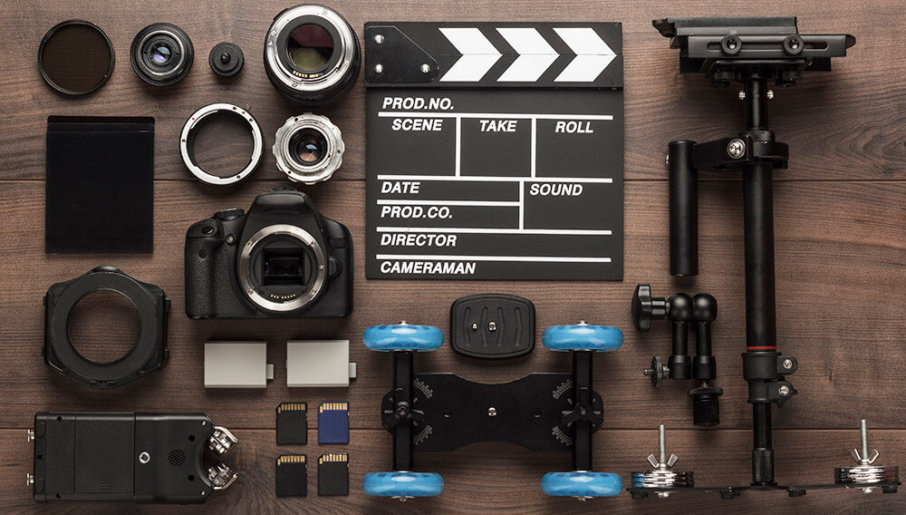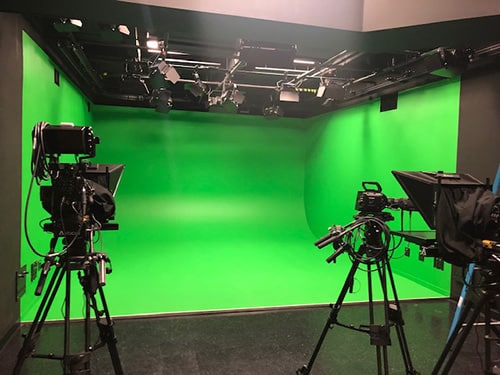Exploring the Most Recent Trends in Video Production for 2025
As we come close to 2025, the video production landscape is poised for significant evolution, defined by improvements in augmented truth and AI-driven modifying tools. The integration of interactive storytelling and immersive 360-degree experiences is redefining target market involvement, while lasting production practices get prominence. Additionally, enhanced real-time streaming abilities are readied to democratize content access like never ever before. These advancements elevate vital concerns regarding the future of creative thinking and technology in video production-- what effects will these trends hold for customers and designers alike?
Enhanced Fact in Video Production
Enhanced truth (AR) is poised to revolutionize video production by perfectly mixing electronic components with live-action video footage. This cutting-edge innovation improves storytelling by providing immersive experiences that involve audiences on a much deeper degree. AR enables filmmakers to integrate interactive graphics, animations, and information overlays straight right into the real-world setting captured on display, producing a vibrant watching experience that typical methods can not achieve.
In 2025, we can expect AR to come to be an integral component of numerous video production procedures, from pre-production planning to post-production enhancements. The ability to visualize complex scenes and aspects in real-time will certainly enable directors and cinematographers to make educated choices during filming. Furthermore, AR can help with remote cooperation, enabling group members to engage with 3D models and aesthetic effects from different locations, thereby streamlining the production operations.
Moreover, marketing and advertising methods will certainly gain from AR assimilation, as brands progressively leverage this technology to develop unique and appealing web content. As consumer demand for cutting-edge and interactive experiences continues to expand, AR will play an important role in forming the future of video production, driving creativity and increasing the opportunities for filmmakers.
AI-Powered Modifying Devices

Boosted Automation Features
The increase of AI-powered editing tools is set to reinvent the video production landscape, enhancing process and improving innovative possibilities. These boosted automation attributes are developed to decrease hands-on labor, enabling material creators to focus extra on storytelling and imaginative vision. By leveraging maker learning algorithms, these tools can evaluate video, determine essential moments, and suggest suitable cuts, significantly decreasing editing time.
One of the most remarkable developments is the capability of AI to adapt and comprehend to different editing and enhancing styles. This capability makes it possible for editors to use particular appearances or categories to their tasks effectively, assisting in an extra individualized technique. Furthermore, AI-driven shade grading and audio editing and enhancing tools can immediately improve visual and audio high quality, guaranteeing a specialist finish without considerable manual adjustments.
Furthermore, the assimilation of automated features in video editing and enhancing software application enables smooth combination with various other production elements, such as modifications and graphics, making the editing and enhancing process more natural. As these devices proceed to develop, they guarantee to democratize video production, allowing customers of all skill levels to develop premium content quickly and successfully, ultimately transforming the market for years to find.
Real-Time Partnership Advantages
Real-time cooperation is ending up being increasingly necessary in video production, especially with the arrival of AI-powered editing tools. These cutting-edge technologies allow numerous stakeholders, consisting of editors, clients, and directors, to work with each other seamlessly, regardless of their physical areas. By promoting immediate feedback and modifications, AI-powered systems enhance the creative procedure, enabling groups to choose rapidly and efficiently.
One of the key benefits of real-time collaboration is the capability to leverage AI for data-driven insights. AI algorithms can assess video footage and suggest edits or shifts that align with the job's vision, streamlining the workflow. This not just increases the editing process however also guarantees that creative selections are informed by historical information and sector fads.
Furthermore, real-time partnership promotes an extra inclusive setting, urging varied perspectives and ideas. Team participants can add their expertise, boosting the overall quality of the production. As video tasks end up being increasingly complicated, the requirement for natural teamwork is vital, and AI-powered editing and enhancing devices are transforming just how imaginative professionals collaborate. Inevitably, these improvements in real-time collaboration are positioned to redefine the landscape of video production in 2025 and beyond.

Improved Individual User Interface
Cutting-edge interface in AI-powered editing and enhancing devices are transforming the video production landscape by enhancing the individual experience and simplifying operations. These tools utilize advanced algorithms to streamline intricate modifying jobs, permitting developers to focus much more on storytelling and creative thinking rather than technological details.
One important development is the integration of instinctive drag-and-drop performances, which enable users to construct their projects flawlessly. Combined with real-time responses devices, editors can imagine modifications quickly, lowering the moment invested in modifications. On top of that, AI-driven functions such as automatic scene discovery and intelligent color grading provide pointers based on job context, substantially accelerating the editing and enhancing procedure.
In addition, the surge of adjustable user interfaces allows customers to tailor their work space to fit specific preferences, improving productivity and efficiency. Editors can prioritize tools and functions they utilize most often, making best use of and lessening interruptions operations fluidity.
As these AI-powered editing and enhancing tools remain to progress, their improved customer interfaces are readied to redefine industry criteria, making high-grade video production easily accessible to a wider series of makers. This pattern not just equalizes video modifying but additionally promotes technology in material production, setting the stage for interesting growths in 2025 and beyond.
Interactive Storytelling Techniques
As video production develops, interactive narration strategies are becoming vital for creating immersive viewer experiences. By including branching narrative frameworks, developers can offer target markets an individualized journey via the material, boosting engagement. Additionally, real-time audience engagement allows for dynamic storytelling that adjusts to audience options, cultivating a much deeper connection with the product.
Immersive Audience Experiences
The development of immersive viewer experiences is changing the landscape of interactive storytelling methods, allowing audiences to engage with stories in unprecedented methods. By integrating virtual reality (VIRTUAL REALITY), augmented reality (AR), and combined reality (MR) innovations, designers are crafting settings where audiences do not merely observe stories yet actively join them. This change in the direction of immersion fosters a sense of presence and psychological investment, transforming easy usage right into dynamic expedition.
Improvements in 360-degree video and spatial audio additionally boost these experiences, allowing users to navigate and engage with their surroundings. Such modern technologies facilitate a multi-sensory approach to narration, where visual and acoustic components are delicately woven with each other to develop a natural narrative. This not only mesmerizes the audience yet additionally encourages deeper links to the material.
In addition, the surge of interactive systems is equipping creators to try out non-linear narratives, providing audiences the capability to affect outcomes and personality arcs in genuine time. As immersive viewer experiences continue to evolve, they are established to redefine exactly how tales are told and gotten, paving the way for ingenious types of web content that reverberate with varied audiences around the world.
Branching Narrative Frameworks
Building upon the immersive audience experiences that have changed interactive storytelling, branching narrative structures are becoming a powerful method to even more engage audiences. These structures allow viewers to influence the instructions of the story, producing a more vibrant and tailored experience. By offering numerous paths and results, web content creators can deal with diverse audience choices and foster much deeper emotional connections with the material.
As innovation advancements, the implementation of branching stories has become more advanced. Modern platforms make it possible for smooth changes in between options, boosting the audience's sense of agency. This interactivity not only mesmerizes audiences but likewise motivates duplicated viewings, as users discover alternative storylines and endings.
Furthermore, branching stories can be properly incorporated right into numerous styles, from gaming to movie and instructional content. This adaptability opens new opportunities for narration, permitting makers to explore intricate character arcs and detailed stories. As we move into 2025, the significance of branching narrative frameworks in video production will likely continue to grow, improving just how tales are informed and experienced, ultimately redefining the partnership between designers and their target markets.
Real-Time Target Market Involvement
Real-time audience interaction is changing interactive narration by enabling makers to attach with audiences in unprecedented methods. This ingenious approach permits audiences to affect narratives as they unfold, improving immersion and emotional financial investment. With advancements in technology, such as online ballot, chat combination, useful site and increased reality, viewers can participate actively, making choices that shape the direction of the tale in real-time.
Platforms leveraging these techniques are not just redefining standard storytelling yet likewise cultivating community interaction. By incorporating functions like live Q&A sessions and interactive personality dialogues, makers can build much deeper connections with their target market, ensuring a more individualized viewing experience. Consequently, narratives come to be more vibrant, adjusting to audience feedback and preferences quickly.
Additionally, real-time engagement improves information collection, supplying important insights right into viewer habits and choices. This details can lead future manufacturings, refining web content methods to better reverberate with target demographics. As we come close to 2025, the integration of real-time target market interaction right into video production will likely become a basic practice, changing how stories are told and experienced. The evolution of interactive narration is not merely an enhancement; it is a crucial change towards a much more interesting and participatory narrative framework.
360-Degree Video Experiences
Immersive video experiences are readied to redefine material usage in 2025, as developments in modern technology proceed to obscure the lines in between fact and digital interaction. The surge of 360-degree video and increased fact (AR) is changing how audiences engage with material, developing possibilities for much deeper emotional links and individualized storytelling.
With the expansion of budget-friendly VR headsets and smart phones with the ability of supporting top quality immersive material, creators can now create videos that put audiences at the center of the action. This shift not only improves viewer interaction however also enables brand names to create one-of-a-kind experiences that resonate with their target market. Creative Video Production. Travel firms can offer online trips of destinations, while educational establishments can imitate complicated atmospheres for immersive understanding.
The combination of interactive aspects in 360-degree videos enables customers to make options that affect the narrative, cultivating a feeling of agency and investment in the web content. As makers explore these modern technologies, we can expect a rise in ingenious storytelling techniques that focus on audience participation. In this developing landscape, the obstacle will be to stabilize imaginative vision with the technical needs of creating premium immersive experiences.
Sustainable Production Practices
As the video production landscape advances with innovative technologies like 360-degree experiences, the market is additionally progressively focusing on sustainable production practices. Recognizing the environmental effect of typical recording methods, production business are adopting green efforts to minimize their carbon footprint.
One substantial pattern is the use of renewable resource sources, such as solar and wind power, to fuel production collections. This shift not just reduces dependence on fossil gas however additionally lowers operational expenses in the long run. In addition, lots of firms are applying digital processes to limit paper use, thereby advertising a much more lasting workflow.

Cooperation with local communities and organizations also plays a crucial function in sustainable techniques, as it lowers and advertises local economic situations transportation exhausts. In general, the commitment to sustainability in video production shows a more comprehensive social change towards environmental stewardship, guaranteeing that future generations can continue to enjoy cinematic storytelling without jeopardizing the earth's health.
Improved Real-time Streaming
The future of video production is being improved by improved live streaming abilities, which are changing just how target markets engage with web content. As modern technology breakthroughs, real-time streaming is coming to be much more interactive and obtainable, enabling designers to attach with viewers in real-time. This shift not just improves audience involvement however additionally promotes a feeling of community around shared experiences.
With the combination of high-def video and audio high quality, combined with low-latency streaming, visitors currently appreciate seamless programs that match traditional tv. Platforms are significantly incorporating features such as multi-camera configurations, interactive polls, and target market Q&A sessions, making real-time occasions much more interesting and vibrant.
Moreover, the increase of decentralized streaming protocols guarantees better dependability and scalability, allowing content designers to reach larger audiences without endangering top quality. As brands and influencers take advantage of these improvements, the potential for ingenious marketing methods through online streaming comes to be apparent
In 2025, we can expect additional advancements in augmented fact overlays and improved analytics, equipping creators to fine-tune their material and tailor it to target market choices. Boosted online streaming is not simply a trend; it is a pivotal component shaping the future of web content consumption and production.
Digital Truth Integration
With boosted online streaming establishing the stage for more interactive experiences, online fact (VIRTUAL REALITY) assimilation is positioned to take audience interaction to unmatched levels. As we approach 2025, the convergence of VR modern technology with video production is transforming how web content is produced and taken in. By involving customers in a 360-degree atmosphere, manufacturers can provide unique experiences that conventional formats can not match.
Brand names are significantly leveraging virtual reality to produce compelling narratives that resonate deeply with target markets. This assimilation enables experiential advertising and marketing, where customers can interact with services or products in a virtual area, promoting an extra personal link. Events such as virtual shows, item launches, and immersive narration sessions are ending up being commonplace, involving users in manner ins which boost retention and psychological investment.
Innovations in equipment and software are making VR more accessible to designers, resulting in a more comprehensive range of material. As production costs reduce and easy to use devices emerge, we can anticipate a rise in ingenious virtual reality projects throughout various industries, from home entertainment to education. The future of video production exists in these immersive experiences, redefining storytelling and audience communication in the electronic landscape.
Regularly Asked Questions
What Are the Vital Abilities for Video Producers in 2025?
Important abilities for video manufacturers in 2025 consist of innovative technical effectiveness in editing and enhancing software, strong storytelling capacities, flexibility to emerging innovations, partnership skills for varied teams, and an eager understanding of target market interaction approaches across systems.
Exactly How Can Independent Creators Gain Access To Advanced Video Production Technologies?
Independent creators can access innovative video production innovations with inexpensive software program systems, cloud-based editing and enhancing tools, open-source resources, and on-line training courses. Cooperations with tech firms and leveraging neighborhood resources additionally improve accessibility to sophisticated production tools.
What Are the Possible Costs Associated With These New Video Production Trends?
The prospective costs connected with emerging video production fads can vary substantially, incorporating expenses for sophisticated tools, software application licenses, training, and workers. Budgeting successfully is vital for developers to utilize these advancements without spending beyond your means.
Just How Can I Determine the Success of My Video Production Efforts?
To determine the success of your video production efforts, assess key efficiency signs such as visitor involvement, conversion prices, audience retention, and responses. Use analytics devices to gather information and derive actionable insights for future improvements.
What Industries Are Many Impacted by Video Production Trends in 2025?
Industries such as advertising, education, home entertainment, and healthcare are greatly affected by arising video production patterns. Video Production. These markets progressively make use of cutting-edge methods to improve involvement, enhance interaction, and provide compelling web content to their corresponding target markets
Ingenious individual interfaces in AI-powered modifying devices are changing the video production landscape by enhancing the individual experience and improving process. As we approach 2025, the assimilation of real-time audience engagement right into video production will likely become a common method, changing how stories are told and experienced. As the video production landscape evolves with cutting-edge innovations like 360-degree experiences, the market is additionally progressively focusing on sustainable production practices. The future of video production is being improved by enhanced real-time streaming capacities, which are reinventing exactly how target markets involve with web content. To measure the success of your video production efforts, examine key performance indications such as customer engagement, conversion rates, audience retention, and comments.